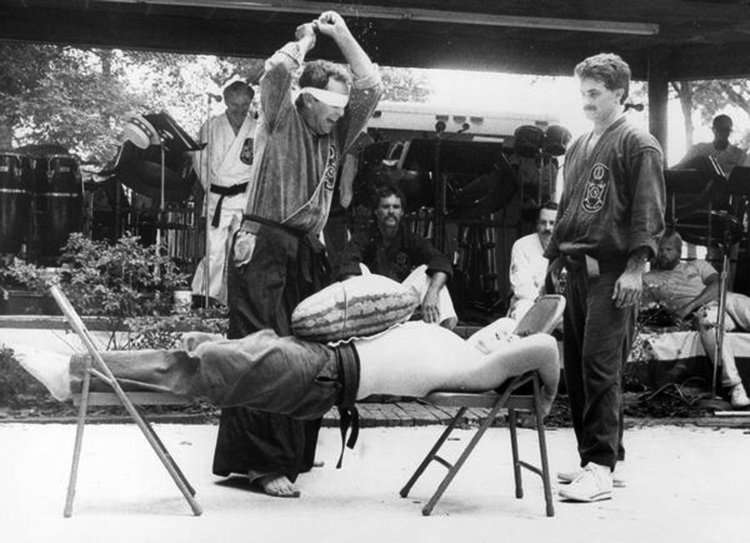I'm reminded frequently that I am getting older, but nothing drives that awareness home like the death of a friend.
My karate sensei, Walter Burmick Appleby of Dumas, died on July 17 at the age of 73. I had been out of touch with my old teacher for years, but he was never really far from mind, even though it's been a quarter of a decade since I had the privilege to train with him.
Sensei roughly means “one who has gone before,” and for me, the word will always conjure images of Sensei Appleby.
I first met Walter in 1987, when he opened the Taiho-Ryu karate school in Dumas, where I was the managing editor of the Dumas Clarion.
He held an open house/demo and I covered it for the newspaper. I'd been practicing karate and Tae Kwon Do for about 8 years at that time, so I joined up with the Taiho-Ryu guys to see what it was all about.
Walter was in his mid-40s and had been an avid karateka (the term for one who practices karate) for decades when I met him. He was powerful and quick, and he would often stay after class for an hour or two regaling us students with stories of his early days in karate, which was pretty much the history of karate in Southeast Arkansas.
For all of his rough and tumble bluster, Walter was pretty much a pussycat, especially when it came to his family — wife Patty, who also was a Taiho-Ryu student at one time; daughters Michelle and Touna and grandchildren Brad, Chase and Samantha.
If you ever drove through Pine Bluff in the 1980s, you'll remember the big billboard advertising Taiho-Ryu karate. Taiho-Ryu was founded by Pine Bluff native Bo Hardy, and as a style, it has a great reputation as a no-nonsense, self-defense based type
of karate.
“Sensei Appleby started training in 1973 and was instrumental in the development of Taiho-Ryu. He was a member of the Taiho-Ryu Hall of Fame and produced many outstanding students and instructors in his 40 year career in Taiho-Ryu,” according to the website, taiho-ryu.org.
Walter was a proud member of the infamous “Stuttgart Samurai,” and along with Sensei Doyle Rowland and Sensei Garland Derden, produced some of Taiho-Ryu's fiercest fighters, who won numerous regional and national titles.
Walter was, like me, more interested in some of the esoteric aspects of martial arts — meditation, energy, history — and we spent countless hours debating and discussing various theories and systems.
Eventually I earned a black belt in Taiho-Ryu, largely due to Walter's encouragement.
As a teacher, Walter was a bit of a prankster. I remember one evening we arrived at class to find the power was out. While we were trying to find the breaker box, suddenly we were being pelted with plastic shurikens (real shurikens are metal throwing stars with sharp points — thankfully these just toys.) Come to find out, Walter was hiding in the dark building in a ninja uniform waiting to ambush us.
Sometimes he'd have training drills for us that made us reconsider our careers as karateka. One such drill involved leaping head first from a 10-foot ladder to land on a mat and tumble out without breaking anything. Another involved jumping over various poles, pads, tables before landing in a roll.
Looking back, it seems like we spent a lot of time hitting the mat. If we weren't practicing falling, then we were being thrown.
One of my favorite photos of Walter is of him dicing a watermelon on the stomach of fellow instructor, Michael Miller, during Ding Dong Days in Dumas in 1989. He did the dicing with a samurai sword, and he was also blindfolded.
He later explained the technique (make sure the person's belt is under the melon for extra protection).
Another time, we were practicing blocking and he was using a wooden sword (called a bokken) to swing at our heads.
“Don't watch my hands, watch my belt,” he told me. I did, only to find myself sitting on the dojo floor with my ears ringing — he'd clocked me on the head with the bokken.
“Well, maybe watch the hands,” he said, laughing.
One of my favorite Walter-isms was “No matter how much a puppy barks, he can't kill a tiger.” His meaning was playing karate twice a week wasn't going to make anyone 10-foot tall and bulletproof, no matter what their 20-something machismo tells them (no doubt he had me in mind when he said it).
Walter approached life with a level of humor and honesty few ever manage to achieve. After retiring from Central Wire as a maintenance supervisor, he went on to become a police officer and had a second career in law enforcement — well past the age where most folks are retired.
Once, he had me take a photo of him with his sword, trying to cut Mr. Miller, while Mr. Miller “blocked” the sword by grabbing the blade. They both screamed at the same time, and it made a great photo.
Walter put the photo in the window of the karate school. Even though it was staged and a bit hokey, he thought it was great.
“That photo will keep trouble makers out, when they see it they'll think, ‘those guys are crazy!’” he said, laughing.
That was my sensei.
Down to earth with just a pinch of magic.
Randal Curtman is the managing editor of the El Dorado News-Times.
